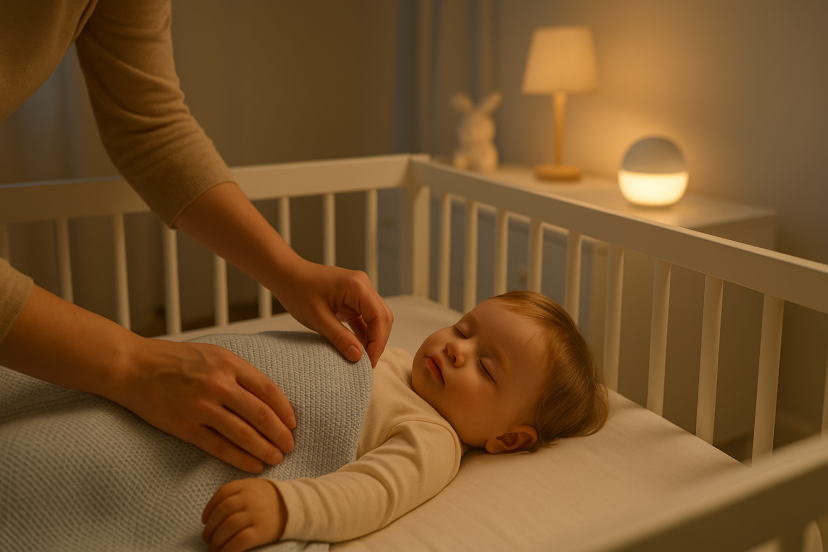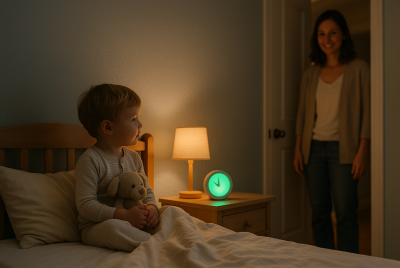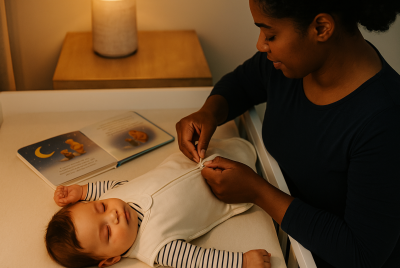Sleep Routine for 12-Month-Old: What Every Parent Should Know
We may earn a commission for purchases made using our links. Please see our disclosure to learn more.
It’s 2 a.m. and you hear tiny feet padding down the hallway—again. If your 12-month-old seems to think bedtime is optional, you’re definitely not alone. At this age, curiosity is blooming, naps are shifting, and independence is growing. The good news? With a consistent sleep routine for your 12 month old, you can rediscover calm evenings and wake up more refreshed (yes, really).
Here’s a warm, practical guide—with a dash of science and real-life tips—to help you build a routine that fits your family.
Why a Sleep Routine Matters at One
Routines are like an emotional anchor. They tell your little one, “The day is winding down; you’re safe; nothing fun is happening without you.” Predictability helps the body’s clock (circadian rhythm) sync up so falling asleep gets easier and night wakings fade. Research backs this up: bedtime routines are associated with earlier bedtimes, faster sleep onset, fewer night wakings, and longer sleep duration.
How Much Sleep Do 12-Month-Olds Need?
At 12 months, your child sits right on the cusp between “infant” and “toddler.” Consensus guidelines recommend 11–14 hours of total sleep per 24 hours for children 1–2 years, including naps.
A healthy day might look like ~10–12 hours at night plus ~2–3 hours of daytime naps. But every baby is different—aim for rested and cheerful, not perfect numbers.
A Real-Life Sample Schedule (Flexible)
| Time | What’s Happening |
| 7:00 AM | Wake & breakfast |
| 9:30 AM | Morning nap (45–60 mins) |
| 12:00 PM | Lunch & play |
| 2:30 PM | Afternoon nap (60–90 mins) |
| 5:00 PM | Snack & wind-down play |
| 6:30 PM | Bath + bedtime routine |
| 7:00–7:30 PM | Lights out |
Tip: If your baby starts resisting the morning nap daily, they’re probably edging toward one nap—common between 13–15 months.
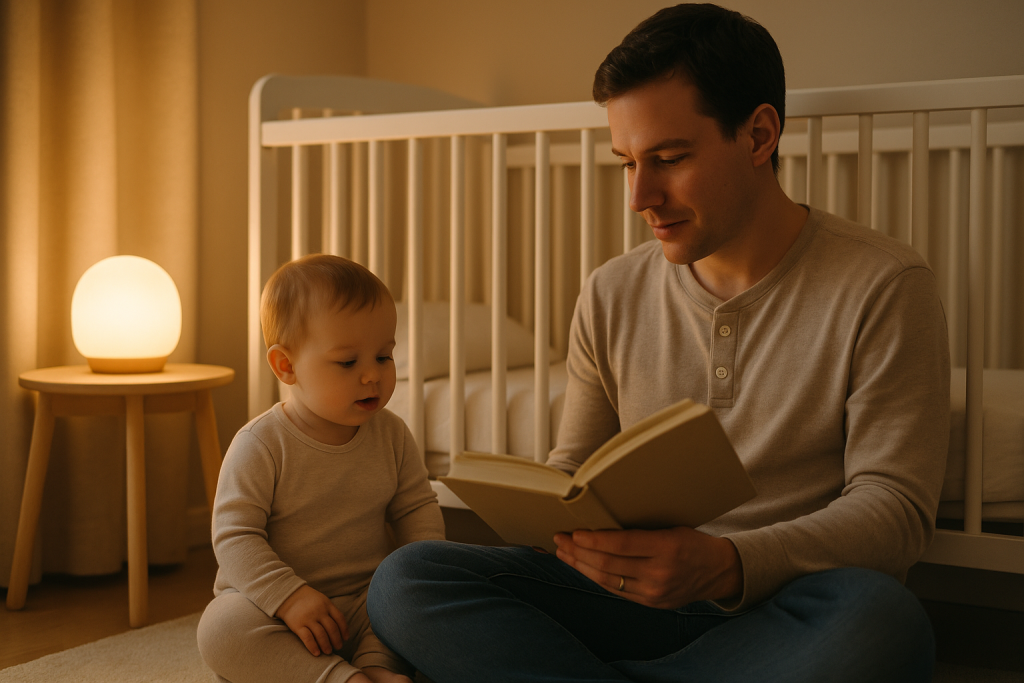
Bedtime Routine, Step by Step
A routine doesn’t have to be long—10–30 minutes is plenty. Try:
- Warm bath → 2) Gentle lotion/massage → 3) Pajamas & sleep sack → 4) Short story or lullaby → 5) Lights out.
Parents in one study saw improvements within days of implementing a simple nightly routine.
The Sleep Environment That Works
Think cool, dark, and calm:
- Blackout curtains to keep early light out
- Consistent white noise (low volume; machine placed across the room)
- Room temperature in a comfortable “cool” range for sleep
- Firm, flat mattress and breathable bedding for safety
Keep sound at a moderate level and avoid placing noise devices close to baby—some infant “sleep machines” can exceed safe levels at near distances.
Nap Transitions: Two to One (Without Tears)
Signs your little one may be ready to drop the morning nap:
- Fighting the morning nap for 5–7 days in a row
- Long party time at bedtime
- Total daytime sleep creeping too high (hurting nights)
Ease into it: shorten the morning nap by 10–15 minutes every few days, push the afternoon nap slightly later, and keep bedtime earlier temporarily during the switch.
Overtired vs. Undertired: Spot the Signs
- Overtired: wired energy, clinginess, false starts at bedtime, trouble staying asleep
- Undertired: happy at bedtime but chats/plays for 45+ minutes, early morning wake-ups
Adjust in 10–15 minute increments—small changes can unlock big wins.
Common Sleep Hurdles at 12 Months (and What Helps)
Night Wakings
- Check basics (teething, illness, temperature, hunger).
- Keep interactions calm and brief—comfort, but avoid bright lights or play.
- Protect daytime naps so bedtime doesn’t start in an overtired state.
Early Rising (before 6 a.m.)
- Try an earlier bedtime for a week (counter-intuitive but often effective).
- Use blackout curtains; keep mornings consistently calm and dim until wake time.
Nap Refusals
- Create a mini pre-nap routine (shade + book + song).
- Watch for sleepy cues; shift nap earlier by 10–15 minutes if needed.
The 12-Month “Regression”
A mix of new mobility, language bursts, teething, and separation anxiety can derail sleep for a few weeks. It’s normal—and temporary.
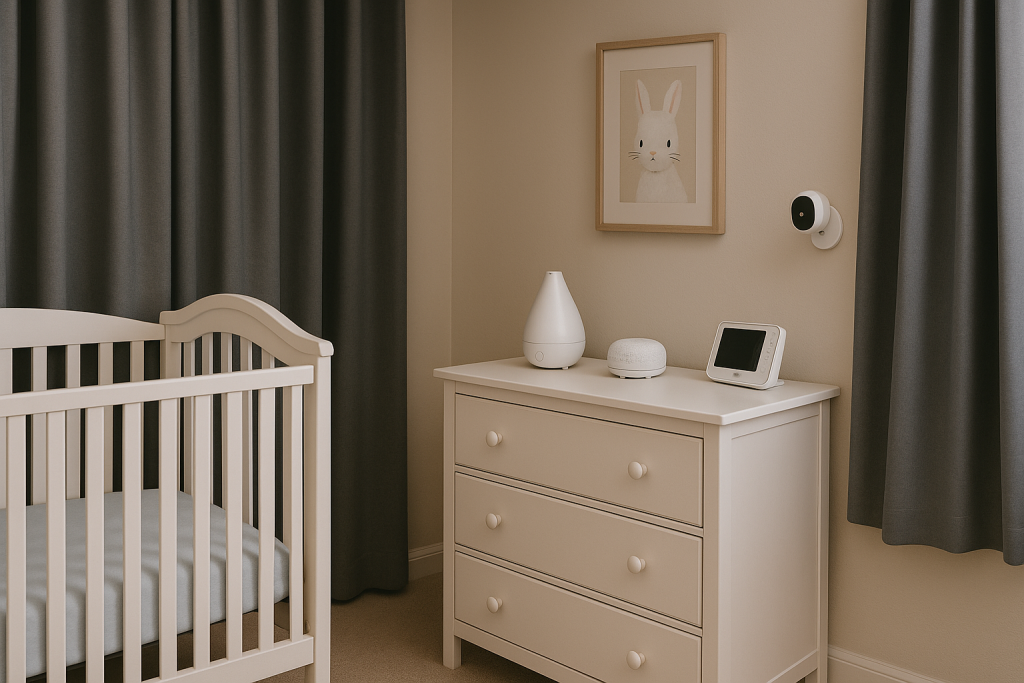
Separation Anxiety: Gentle, Attachment-Focused Strategies
Separation anxiety commonly surges around 10–18 months, so if bedtime protests feel big, you’re not imagining it.
Try: a simple “goodnight” phrase, a consistent exit routine (“I’ll be back to check in 2 minutes”), and a cozy lovey if age-appropriate. Your calm repetition builds trust.
Food, Sunlight & Movement: Daytime Habits That Boost Night Sleep
- Morning light helps set the body clock.
- Active play increases sleep drive.
- Predictable meals support steady energy.
These sleep-hygiene basics are kid-friendly and research-supported.
Travel, Teething & Illness: Keep the Rhythm Without Starting Over
- Travel: replicate key cues (same sleep sack, sound machine, bedtime book).
- Teething/illness: offer comfort, but keep your routine skeleton in place.
- After recovery: return to usual timing within 2–3 days.
Gentle Sleep Training Options at One (If You Want Them)
- Chair method: Sit by the crib and gradually move farther away each night.
- Timed checks: Brief, calm check-ins at set intervals.
- Pick-up/put-down: Reassure, then lay down again before full wakefulness.
You don’t have to choose a method at all—but if you do, consistency beats intensity every time.
Cultural Bedtime Rhythms: Make It Yours
Some families co-sleep; others prefer separate rooms. Some value later family dinners; others love early lights-out. The “right” routine is the one you can repeat with love and relative ease.
Amazon Picks: Parent-Tested Sleep Helpers (Curated)
Below are five popular products parents lean on. (Use as helpful tools—not magic wands.)
💤 1. Hatch Rest+ 2nd Gen Sound Machine & Night Light
What It Is:
An all-in-one device combining a white noise machine, customizable night light, and time-to-rise indicator.
Key Features:
- App-controlled (Bluetooth/Wi-Fi)
- Gentle, adjustable sound and color settings
- “OK to wake” feature for toddlers
Pros:
✅ Grows with your child — from baby to preschooler
✅ Promotes healthy sleep cues with light + sound
✅ Sleek, modern design
Cons:
❌ Higher price point than basic machines
Best For:
Parents who love smart devices and want a single sleep solution.
🌙 2. Nested Bean Zen Sack Classic (Wearable Blanket)
What It Is:
A gently weighted sleep sack designed to mimic your touch, helping babies feel secure.
Key Features:
- Lightly weighted pad over chest
- 100% cotton, breathable, and machine-washable
- Available in multiple sizes and patterns
Pros:
✅ Helps soothe babies transitioning from swaddling
✅ Safe alternative to loose blankets
✅ Supports self-soothing
Cons:
❌ Outgrown quickly during growth spurts
Best For:
Babies who wake frequently seeking comfort or physical reassurance.
🐧 3. Tommee Tippee 2-in-1 Portable Penguin Night Light
What It Is:
A charming dual-function night light and portable torch designed to comfort toddlers and make nighttime navigation easier for parents.
Key Features:
- Soft, warm glow that’s gentle on baby’s eyes
- Penguin-shaped light that detaches from its base
- Rechargeable via USB cable
- Child-safe, cordless, and easy to carry
Pros:
✅ Two functions in one — night light + portable torch
✅ Perfect brightness for bedtime routines or late-night feeds
✅ Adorable, gender-neutral design that kids love
Cons:
❌ Limited color settings (warm white only)
❌ Slightly dim for large rooms
Best For:
Parents seeking a portable, low-stimulation night light that’s both practical and playful.
🌿 4. Frida Baby 3-in-1 Humidifier, Diffuser & Nightlight
What It Is:
A multifunctional cool-mist humidifier that doubles as a diffuser and nightlight.
Key Features:
- Diffuses essential oils safely
- Adjustable mist levels
- Built-in color-changing nightlight
Pros:
✅ Adds moisture for easier breathing
✅ Perfect for dry climates or winter months
✅ Whisper-quiet operation
Cons:
❌ Small tank (requires frequent refills)
Best For:
Families wanting fresher air and a calming sleep environment.
📷 5. VTech VM819 Video Baby Monitor (No Wi-Fi Needed)
What It Is:
A reliable video baby monitor with clear audio and long-range connectivity.
Key Features:
- 2.8” screen with night vision
- Two-way talk and lullaby options
- Up to 19 hours of battery life
Pros:
✅ No Wi-Fi required — secure and private
✅ Strong, stable connection
✅ Easy plug-and-play setup
Cons:
❌ No mobile app for remote viewing
Best For:
Parents who prefer simplicity, safety, and peace of mind without tech hassles.
Quick Comparison
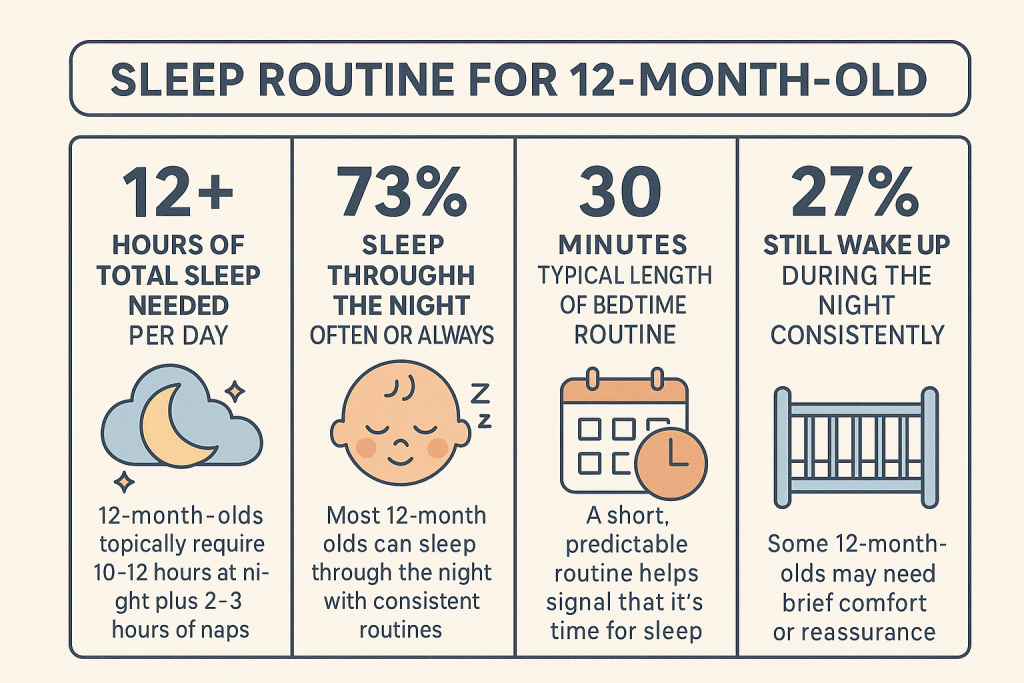
| Product | Highlights | Best For | Cons |
| Hatch Rest+ 2nd Gen | App-controlled sound & light combo | Smart-home parents who want an all-in-one bedtime tool | Higher cost |
| Nested Bean Zen Sack Classic | Weighted chest pad for comfort | Transitioning sleepers needing gentle reassurance | Size limitations |
| Tommee Tippee Penguin Night Light | 2-in-1 night light + portable torch | Parents wanting soft, portable lighting | Limited brightness / single color |
| Frida Baby 3-in-1 Humidifier | Humidifier + diffuser + night light | Families in dry climates or seeking calming air quality | Small water tank |
| VTech VM819 Monitor | Long-range video & two-way audio | Low-tech peace of mind — no Wi-Fi needed | No app or cloud access |
Research-Backed Insights (Plain-English Summaries)
Consistent bedtime routines improve sleep quality.
A large study of young children found that a nightly routine correlates with earlier bedtimes, shorter time to fall asleep, fewer night wakings, and longer total sleep. The benefits increased the more consistently families followed the routine. Translation: small, repeatable habits work wonders. (See the bedtime routine and sleep outcomes study.)
How much sleep really matters.
The American Academy of Sleep Medicine advises that children 1–2 years need 11–14 hours per day (including naps). This range supports health, development, and mood—and reminds us that “enough” is a spectrum, not a single number. (See the AASM child sleep duration advisory.)
FAQs
What time should a 12-month-old go to bed?
Most families do well with 7:00–8:00 p.m. It pairs nicely with a 6:00–7:00 a.m. wake window and helps protect 10–12 hours at night for many children.
How long should naps be at this age?
Aim for ~2–3 total hours of daytime sleep split between one or two naps (as your child transitions). Follow sleepy cues and adjust by 10–15 minutes as needed.
Is white noise safe for babies?
Yes—when used correctly. Keep the device across the room at low volume and avoid placing it near the crib; some infant machines can be too loud up close.
My 12-month-old suddenly started waking at night. Is this a regression?
Often, yes—linked to mobility, language leaps, or separation anxiety. Stay consistent; most regressions pass in a few weeks.
Is sleep training required at one year?
Nope. Many families improve sleep with routine tweaks, environment changes, and gentle reassurance. If you choose a method, consistency matters more than which method.
Helpful Resource
Want to create a calm sensory cue at bedtime? See this practical primer on using room diffusers and essential oils with babies to keep wind-down gentle and safe.
Resource: Room diffusers and essential oils for babies—what to know
The Takeaway
A great sleep routine for a 12 month old isn’t about perfection—it’s about consistency, connection, and calm. Anchor the evening with a simple ritual, protect naps, keep the room cool/dark/quiet, and ride out the wobbles with kindness. With a few steady habits, you’ll both start waking up to brighter mornings.

